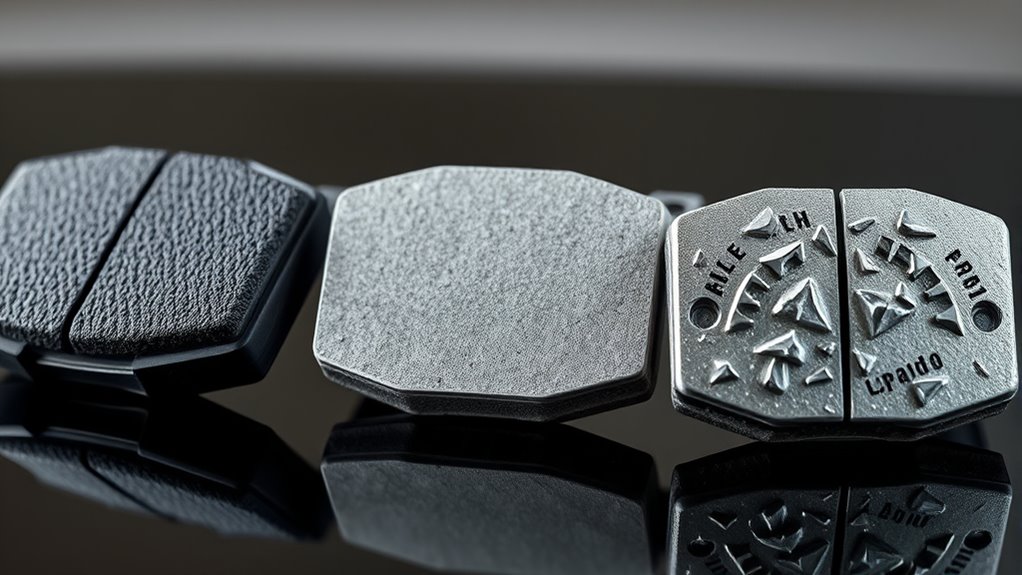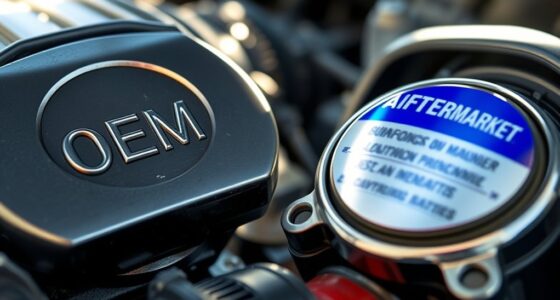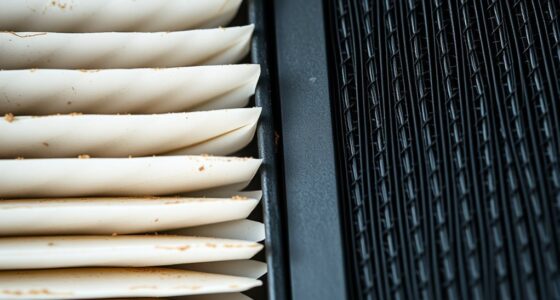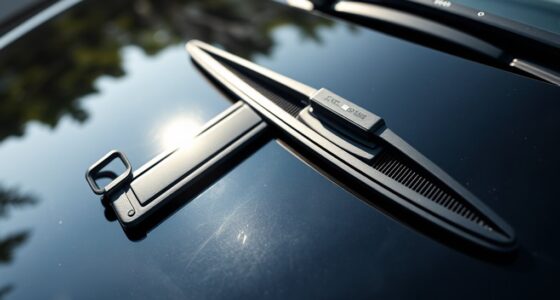When choosing brake pads, consider organic, ceramic, and metallic options based on your driving needs. Organic pads are softer, quieter, and more comfortable but wear out faster and offer less stopping power under stress. Ceramic pads last longer, produce less dust, and perform well in most conditions, making them a versatile choice. Metallic pads excel in high-performance situations, resisting heat and providing stronger stops but can be noisier. To find the best fit, explore how each type matches your driving style.
Key Takeaways
- Organic brake pads offer quiet, smooth braking suited for daily driving but wear out faster and provide less stopping power.
- Ceramic brake pads are durable, produce minimal dust, and perform consistently across various temperatures, ideal for regular use.
- Metallic brake pads deliver high-performance stopping power, withstand extreme heat, and are suitable for demanding driving conditions like towing.
- Cost varies: organic pads are the cheapest, ceramics are moderate, and metallic pads tend to be more expensive.
- Choice depends on driving needs: organic for comfort, ceramic for versatility, and metallic for high-stress or performance driving.

Brake pads are an essential component of your vehicle’s braking system, responsible for slowing down or stopping your car safely. One of the key factors that influence their performance and durability is the brake pad material. Different materials have unique properties that affect how well they perform, their brake pad lifespan, and how they interact with your vehicle’s braking system. Understanding these differences helps you choose the right brake pads for your driving needs.
Organic brake pads are made from materials like rubber, glass, and resins, bonded together to create a softer, more forgiving surface. They tend to produce less noise and generate less brake dust, making them a popular choice for daily drivers and those seeking quieter braking. However, because organic pads are softer, they tend to wear out faster, which means a shorter brake pad lifespan. They also typically provide less stopping power compared to other materials, especially under high-stress conditions such as mountain driving or towing. If you prioritize comfort and quieter operation over longevity and maximum stopping power, organic brake pads might suit you.
Ceramic brake pads are composed of dense ceramic fibers mixed with copper fibers, which give them a distinctive balance of performance and durability. They generally offer a longer brake pad lifespan than organic pads, thanks to their harder material composition. Ceramic pads are known for their consistent braking performance, minimal brake dust production, and quieter operation. They tend to perform well in a variety of driving conditions, including high-temperature scenarios, making them suitable for everyday street driving and even some spirited driving. Although they tend to be more expensive upfront, their durability and reduced maintenance costs often justify the investment. Additionally, ceramic pads are often valued for their consistent performance, which helps maintain safety and reliability over time.
Metallic brake pads, also called semi-metallic or fully metallic, are made from a blend of metals like copper, iron, and steel. These pads excel in high-performance situations because they can withstand extreme heat and provide exceptional stopping power. Metal brake pads have a longer brake pad lifespan compared to organic pads, especially when used in demanding driving conditions. However, they tend to be noisier and produce more brake dust, which can lead to more frequent cleaning of your wheels. If you frequently drive in hilly areas, engage in spirited driving, or tow heavy loads, metallic brake pads are often the best choice because of their ability to handle intense heat and stress.
Frequently Asked Questions
Which Brake Pad Type Is Best for High-Performance Racing?
For high-performance racing, you want brake pads that maximize tire grip and minimize brake fade. Metallic pads often deliver the best stopping power and heat resistance, making them ideal for intense racing conditions. They handle high temperatures well and maintain consistent performance. Organic and ceramic pads might offer quieter operation, but they typically don’t match metallic pads in providing the grip and fade resistance needed for racing.
Are Organic Brake Pads Environmentally Friendly?
You’re asking if organic brake pads are eco-friendly, and it’s a bit of a double-edged sword. While they often contain natural, eco-friendly materials and produce less harmful dust, biodegradability concerns come into play. They tend to wear faster, releasing more particles into the environment. So, although they seem greener at first glance, their overall environmental impact depends on factors like lifespan and disposal methods. It’s not a clear-cut answer, but they’re generally better for the planet than metallic options.
How Often Should I Replace My Brake Pads?
You should check your brake pads regularly to determine their condition, as their lifespan varies based on driving habits and pad type. Typically, brake pad replacement intervals range from 25,000 to 70,000 miles. Pay attention to signs like squealing or reduced braking power, which indicate it’s time for replacement. Regular inspections make sure safety and help you avoid costly repairs, keeping your vehicle running smoothly.
Can Brake Pads Be Mixed From Different Materials?
Ever wondered if mixing brake types is safe? Mixing brake pads from different materials isn’t recommended, as it can affect material compatibility, leading to uneven wear or reduced braking performance. Different materials like organic, ceramic, and metallic have unique characteristics, and combining them may cause issues. For ideal safety and efficiency, stick to the same brake pad material for each axle, and consult your vehicle’s manual or a professional before making changes.
What Are the Signs of Worn-Out Brake Pads?
You’ll notice signs of worn-out brake pads through brake pad noise, like squealing or grinding sounds when braking. You might also feel a soft or spongy brake pedal or reduced braking performance. It is crucial to perform a brake pad inspection regularly to catch wear early. If you detect any of these signs, get your brake pads checked and replaced promptly to maintain safe braking and avoid further damage.
Conclusion
Now that you’ve explored organic, ceramic, and metallic brake pads, it’s clear that choosing the right one depends on your driving style and needs. Coincidentally, the right pad can surprise you with better performance just when you least expect it. So, whether you prioritize quiet braking or durability, knowing these options helps you make a smarter choice. After all, your car’s stopping power is only as good as the pads you pick—so choose wisely!









